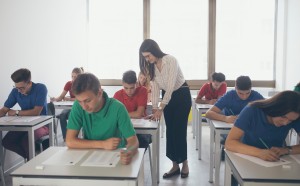Proximity
Using proximity refers to physically positioning the teacher close to a student. Proximity can be used as a whole group strategy or for individual students. With the whole group, the teacher can intentionally move through the classroom during instruction, creating opportunities to be near each student for a period of time, demonstrating supervision and availability for assistance. As an individual strategy, the student may be seated in a spot close to the teacher’s instructional position, or the teacher may notice a behavior error beginning and move toward the student as a cue to return to expected behavior.
Example: When Alan is off task or talking, the teacher continues to teach the group while, at the same time, moving toward Alan or even standing next to him for a moment. Once Alan brings his behavior in line, brief specific positive feedback will help to maintain the desired behavior, for example, “Thanks, Alan for showing respect with your attention. 
Signal/Non-verbal Cue
Teachers have a variety of signals that communicate to the student what is expected. These non-verbal techniques include such things as eye contact, hand gestures, picture cues, etc. Such simple cues suggest that the teacher is aware of the student’s behavior and is prepared to intervene if the behavior continues. This works best when the teacher has a relationship with the student(s) and the non-verbal cues have already been taught to the group.
Example: When Sarah begins to talk to her neighbor, the teacher glances in her direction and holds the look until she is again quiet and attending. The teacher then praises Sarah for her attention. 
Example: The group of students is getting restless. The teacher uses her hand signal to regain their attention, then praises the group and reminds them of the expectations for independent work time.
Ignore/Attend/Praise
This technique is based on the power of praise or specific positive feedback. The teacher praises an appropriately behaving student in proximity to the inappropriately behaving student. The praise serves as an indirect prompt for the misbehaving student and reinforcement for the one behaving appropriately. When the student exhibits the appropriate behavior, attention and praise is then provided.
Example: James is off-task during independent work time. The teacher briefly ignores James, and specifically praises a student nearby who is on task, “Good work, Carlos. You are making great progress on your assignment.” When James begins to get back to work, the teacher then, immediately, praises him: “Thanks, James for being on task; you’ll be sure to get your work done.”


